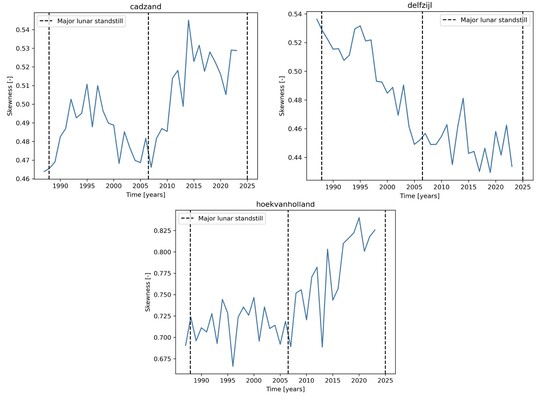K.B. Haakman1*, D.C. Slobbe1 , M. Verlaan1,2
1 Delft University of Technology, The Netherlands; 2 Deltares, The Netherlands
* Corresponding author: k.b.haakman@tudelft.nl
Introduction
Tidal asymmetry plays a crucial role in sediment transport and morphological evolution in coastal systems. Temporal variations in tidal dynamics due to e.g. coastal engineering, sea-level rise or increasing ocean stratification can also cause changes in tidal asymmetry. Along the Dutch coast, these factors have contributed to decadal variations in tidal characteristics.
Objective and Methods
This study aims to quantify the evolution of tidal asymmetry along the Dutch coast over the past decades. We analyze surface elevation measurements from tide gauges spanning 1987 to 2024, computing the skewness of the time derivative of water level time series for each year. This metric provides insight into the relative duration and intensity of rising versus falling tides, which affects net sediment transport. Further, the contribution of different combinations of tidal constituents to the skewness is computed which could aid in the attribution process.
Results
Our findings reveal spatially variable trends in tidal asymmetry along the Dutch coastline. In the southwest Netherlands, a coherent increase of approximately 15% in tidal skewness is observed at the Cadzand, Westkapelle, Vlissingen, and Hoek van Holland tide gauges. This increase suggests an increasing flood dominance, which may enhance landward sediment transport. Conversely, at Delfzijl, tidal skewness has decreased by about 20%, indicating a reduction in flood dominance. Understanding these trends is important for anticipating changes in sediment transport and informing sustainable coastal management strategies.

Time series of water level derivative skewness at selected Dutch tide gauges.










